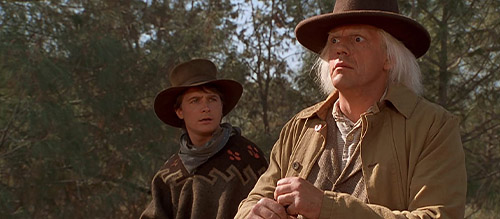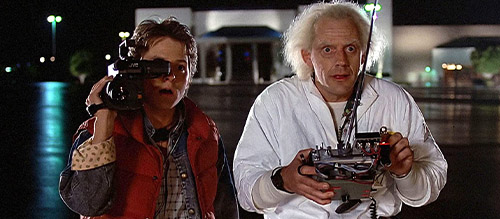Back to the Future Movies Ranked
2. Back to the Future Part III (1990)
With the lowest IMDB, Letterboxd and Rotten Tomatoes audience rating, Back to the Future Part III seems to be the forgotten film of the trilogy, or at least the most divisive. However, with a critic rating of 80% vs Back to the Future Part II’s 65%, Part III earned somewhat more positive reviews and has perhaps shown better longevity, its turning of the trilogy on its head by combining the western with the sci-fi/fantasy elements of the other two films earning its spot in second place on our list.
Much like Part II, the third installment is not without casting issues. Lea Thompson plays Marty’s great great grandmother on his father’s side, when she is his mother, for example, and the less said about Doc’s children at the end of the film the better. However, the addition of Mary Steenburgen as Clara is a breath of fresh air that introduces a new, more in control and self-reliant version of a woman to the trilogy.
Clara’s connection to Doc is one that feels genuine and aides his development from the Doc of parts I & II. We see Doc happy, searching for more than the science that has brought him immense discovery at the expense of such personal growth, and we importantly see him outgrow his need for Marty and thus set his teenage disciple on his way into adulthood.
As was the case with the other two films, the narrative is simple enough: repair the Delorean to get Marty back to 1985. But the Western setting of 1885 genuinely boosts the fish out of water jokes played at Marty’s expense, and it seems to give purpose to Marty’s aversion from the previous films of being called “yellow” or “chicken”. In the context of a Western, the Back to the Future bedrock of a western narrative twisted for modern audiences through a sci-fi context comes home to roost, Gale and Zemeckis embracing their Western movie inspirations with the ultimate tongue in cheek move of a franchise built on the same very tongue in cheek attitude.
Easier to follow than Part II, and featuring significant character growth and audience fulfillment, Back to the Future Part III may not look like the other two franchise entries, but it maintains its unique charm nonetheless while fulfilling way more as an overall storytelling device than Part II does, thus becoming the 2nd best film of the trilogy.
Recommended for you: Live-Action Batman Movies Ranked
1. Back to the Future (1985)
With one of cinema’s great openings – Steven Spielberg presents you this Zemeckis classic – we are introduced to both Marty and Doc. It’s 07:53, the chain reaction of your childhood dreams begins, a mechanism setting into motion a series of events including turning on the tv, brewing the coffee and even feeding the dog – all automatically of course. We learn through the noise of the TV that plutonium has been stolen and Libyan terrorists claim they have taken it. Our protagonist Marty McFly enters, his skateboard rolling across the floor, hitting said plutonium which is being stored on the underside of Doc’s bed. Marty is cool, he skateboards, he’s a pretty great guitarist – did you know that Michael J. Fox did actually play the guitar in this film? – so he turns a rather ginormous amp all the way to full, plays one note and gets blown across the room, blowing the speaker in the process.
Wow.
A skateboard riding, car-hitching montage of pop-rock music from Huey Lewis and the News later, and Marty arrives at school. From there we learn that time travel exists, and that Doc has somehow restored the reputation of the Delorean to be a cool car… bat-wing-like doors and all.
The reason why Back to the Future is the best movie of the trilogy is that it has all the elements of the later films but it doesn’t attempt to be too clever or even too big – it knows exactly what it is. In Part I, Marty is sent back to 1955, the year that Doc came up with the invention for the flux capacitor and the year in which Marty’s parents met. He inadvertently changes the course of history by interfering with his parents’ first meeting and is therefore tasked with making them fall in love so as to ensure his own birth.
The film works terrifically well to sell the idea of nostalgia for a much simpler 1950s, even going so far as to be shot like a great film of the era, Zemeckis clearly taking lessons from Spielberg on how to present a radiant vision of small town USA. There are elements of action, science fiction, comedy and the western, all of which play off one another to create a truly unique family film that is written, directed, shot and performed about as perfectly as any one family blockbuster ever made.
This is a film that you can watch anytime and with anyone. There are jokes for adults, and some of the themes are clearly adult, but as with all family classics there is something for everyone and it’s all presented in such an understandable and entertaining way. Back to the Future is a film that works both as the beginning of a trilogy – featuring possibly the best closing line in the history of mainstream cinema: “where we’re going, we don’t need… roads” – but also stands up on it own. Even now, some three and a half decades later, this is the Back to the Future film we all think of, and the one we think of with the most fondness and happiness.
In a trilogy of great blockbuster movies, it’s the original outing that remains its most remarkable achievement.
What’s your opinion? Would you have ordered them differently? Let us know in the comments, and don’t forget to tweet us.



